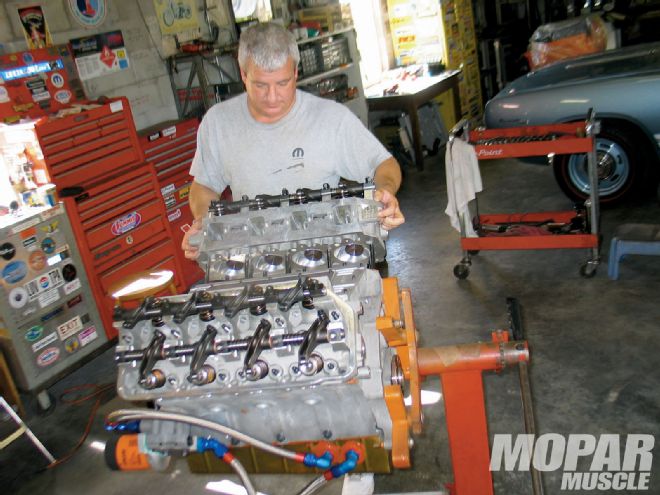
When it comes to the engine in our Mopar, we all want an abundance of power (isn't that why we drive Mopars?), but there are other important aspects regarding the powerplant that sits between the frame rails of our car. For a powerful engine to last, it must be able to withstand the forces placed on it during its life, especially in high-rpm or high-load applications, without over-stressing itself or breaking an internal part that would lead to engine failure. Chrysler did a pretty good job designing their high-performance V-8 engines to withstand their rated power levels, and stock Mopar muscle car engines often lasted far longer than the engines in their competitors' vehicles. Engine technology has come a long way in the past four decades though, and by today's standards the engines in our muscle cars definitely utilize outdated technology.
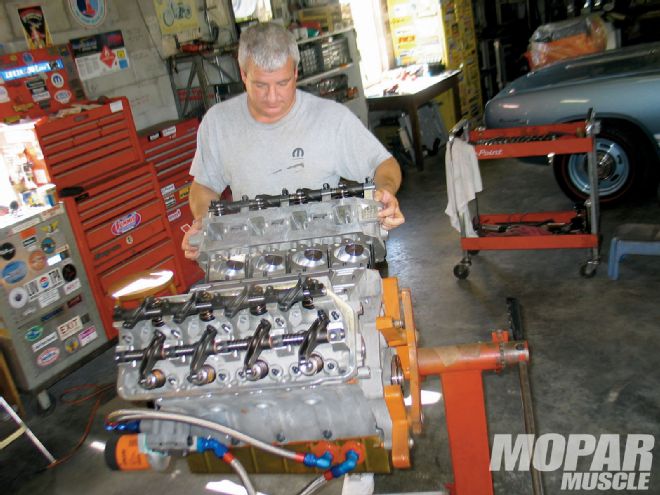 Most of us only want to pay to rebuild the engine in our Mopar once, so we want it done properly. This month we'll show you some techniques we used when building an all-out race Hemi, and these same methods can be applied to your engine as well.
Most of us only want to pay to rebuild the engine in our Mopar once, so we want it done properly. This month we'll show you some techniques we used when building an all-out race Hemi, and these same methods can be applied to your engine as well.
To properly build a high-performance engine, it takes a good selection of the right parts, as well as accurate inspection, machining, and assembly techniques, to result in an engine that is not only powerful, but durable as well. And while durability isn't usually the first thing that comes to mind when building an engine, it is vitally important if you want to be able to properly enjoy your vehicle. Durability means that at the track, you're the racer who runs quick, consistent elapsed times or lap speeds, without having to open the hood of your car during an event. On the street, durability means not worrying about driving on that long cruise or taking your car on a trip or to the track, because you're confident nothing will break. But while knowing the importance of engine durability is one thing, actually achieving it is an entirely different matter. It takes the proper tools, techniques, and parts to build an engine that lasts, and often the experience needed is gained by testing parts and theories on the dyno or at the racetrack.
One of the reasons we do so much racing is because we know the rigors of racing are the ultimate test of engine parts, and the technology used in race engines can often be applied to street or dual-purpose engines as well. This is no secret, as auto manufacturers have been utilizing this theory for many years, applying cutting edge racing technology to the engines they produce for their street cars and building more powerful and robust production engines each year. So, while we know most of you won't get the chance to build your own all-out race Hemi, we thought we'd let you follow along while we build one, showing you the parts and techniques we used, many of which can be applied to your street engine as well.
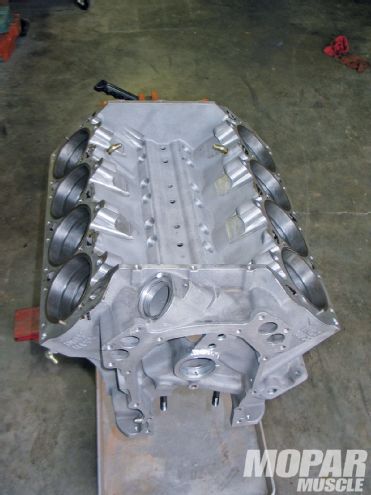 Starting with quality parts will ensure the motor is not only powerful, but durable as well. We chose an Indy Maxx aluminum, water-cooled block from Indy Cylinder Head because of its light weight and its ability to sustain high loads without failure.
Starting with quality parts will ensure the motor is not only powerful, but durable as well. We chose an Indy Maxx aluminum, water-cooled block from Indy Cylinder Head because of its light weight and its ability to sustain high loads without failure.
The subject of our build is a 540 cubic inch all aluminum Hemi we're putting together for a friend and local Mopar enthusiast who lives on the West coast of Florida. This engine is a full-blown race motor, which will eventually reside in a tube-chassis '68 Dodge Dart. Due to its power potential, this engine will be built using all aftermarket parts, including an Indy Maxx aluminum, water-cooled block, Indy CNC ported aluminum cylinder heads, a Comp roller cam, Milodon oil system, and a mixture of forged and billet internals from Summit Racing. Experience tells us that this high-compression race engine has the potential of nearly 1,000 horsepower and 8,500 or more rpm if equipped with tunnel-ram induction, but Joe chose a cross-ram intake manifold which will limit the engines output to around 900 horsepower. Even so, the loads and pressures on the internal and external engine parts will be immense, so only the best parts, and the most precise machining techniques, will ensure this engine's longevity.
Any time you build an engine, or have one built, you must define the intended use of the engine, which will determine the minimum quality of parts necessary. Since this engine is an all-out race piece, we'll be using some of the best parts on the market to build it. Also remember that even at the top level of performance, there are still equivalent parts made by competing companies. In these cases, the engine builder generally uses his or her personal experience, choosing the part based on parameters like weight, dimensional accuracy, application, etc. The one way we don't choose our parts is by price. While it is true that some of the best parts are expensive, it's also true that highest-priced parts aren't always the highest quality, or could be overkill for an engine that makes only moderate power.
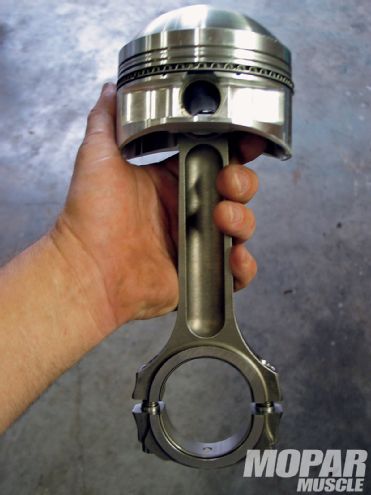 Nothing less than quality forged-pistons will survive in an engine like this, and you should consider forged pistons mandatory in your rebuild as well, even if your engine is staying close to stock. We're using Oliver billet connecting rods in this normally aspirated Hemi, and would use an aluminum connecting rod if this engine were boosted or nitrous oxide injected.
Nothing less than quality forged-pistons will survive in an engine like this, and you should consider forged pistons mandatory in your rebuild as well, even if your engine is staying close to stock. We're using Oliver billet connecting rods in this normally aspirated Hemi, and would use an aluminum connecting rod if this engine were boosted or nitrous oxide injected.
Accurate machine work is also vital to the power and durability of a high-performance engine. You can assemble your engine with the best parts in the world, but if the cylinders aren't round, the decks aren't square, or the valve guides have too much clearance, it won't make the power you expect it to or last as long as it should. In a street car, this isn't often apparent as initially two engines with vast differences in quality might seem to make similar power. However, in six months, a year, or two years, the engine built with higher-quality parts and accurate machining will still be running strongly and consistently, while the other engine may smoke, burn oil, perform poorly, or not run at all. In racing applications, the lesser engine quickly makes itself apparent by a lack of power, requiring constant maintenance, or by spilling its guts and oil out the bottom (or sides) of the oil pan.
In our part of central Florida, we use Auto Performance Engines for their machine shop services. Owner Kevin Willis runs a clean shop, has high-quality, updated equipment including a Superflow engine dyno, and he's not scared to tell us something isn't right even if he knows we won't be happy. These qualities are also possessed by the shops in our AMSOIL/Mopar Muscle Engine Challenge, and should be what you look for when choosing a machine shop to perform your work. Don't assume just because a shop builds off-brand racing motors that they have the equipment like torque plates for Mopar engines so they can perform your work properly. This is an area where you don't want to cheap-out. Performing machine work to the highest standard takes extra time, and a shop doing such work will replace tooling more often to ensure accuracy, but the money you'll spend upfront will certainly be worth it when your engine provides years of good service.
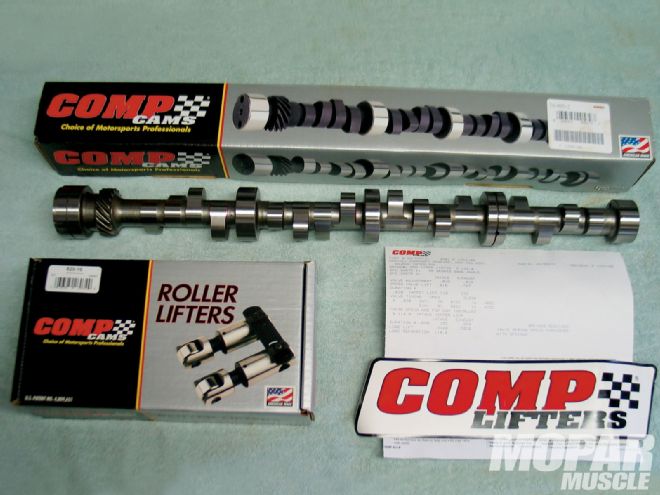 We're using a very aggressive solid roller camshaft with lift numbers in the .800-inch range, and a duration of 285/294 at .050-inch lift. The cam and lifters are from Comp. With this kind of lift, duration, and ramp rate, careful attention must be taken to check clearances like valve guide to retainer, coil bind, and piston-to-valve clearance.
We're using a very aggressive solid roller camshaft with lift numbers in the .800-inch range, and a duration of 285/294 at .050-inch lift. The cam and lifters are from Comp. With this kind of lift, duration, and ramp rate, careful attention must be taken to check clearances like valve guide to retainer, coil bind, and piston-to-valve clearance.
Assembling the engine also requires a special touch, patience, and a certain amount of precision tooling. Just as importantly, the assembly area must be clean as well as all of the engine parts and tools. Before you use your socket set to tighten any of the fasteners inside an engine, think about where your tools have been. If you were just crawling in a gravel driveway tightening the muffler clamps on your '78 custom van, you don't want to transfer that dirt and rust into the engine you're building. This is one of the many reasons to either have clean, dedicated engine building tools, or to have a professional build your engine for you. If neither of these options is possible, we suggest completely cleaning the tools in a parts washer or with brake cleaner, then soap and water, just like the engine components.
Now that we've told you why it's important to use the proper parts, accurate machining, and proper assembly techniques, let's get busy building this big Hemi. Follow along and you'll certainly learn a trick or technique that you can apply to your next engine build. And if you're planning to have an engine shop build your next engine for you, this article should give you the information you'll need to choose a shop properly.